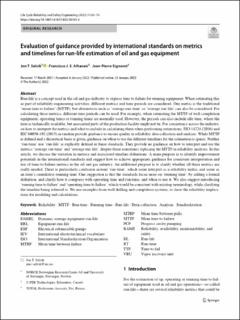| dc.contributor.author | Selvik, Jon Tømmerås | |
| dc.contributor.author | Alhanati, Francisco JS | |
| dc.contributor.author | Signoret, Jean-Pierre | |
| dc.date.accessioned | 2023-04-13T07:11:17Z | |
| dc.date.available | 2023-04-13T07:11:17Z | |
| dc.date.created | 2022-12-19T14:59:04Z | |
| dc.date.issued | 2022 | |
| dc.identifier.citation | Selvik, J. T., Alhanati, F. J., & Signoret, J. P. (2022). Evaluation of guidance provided by international standards on metrics and timelines for run-life estimation of oil and gas equipment. Life Cycle Reliability and Safety Engineering, 11(1), 61-74. | en_US |
| dc.identifier.issn | 2520-1352 | |
| dc.identifier.uri | https://hdl.handle.net/11250/3062767 | |
| dc.description.abstract | Run-life is a concept used in the oil and gas industry to express time to failure for running equipment. When estimating this as part of reliability engineering activities, different metrics and time periods are considered. One metric is the traditional ‘mean time to failure’ (MTTF), but alternatives such as ‘average run-time’ or ‘average run-life’ can also be considered. For calculating these metrics, different time periods can be used. For example, when estimating the MTTF of well completion equipment, operating times or running times are normally used. However, the periods can also include idle time, where the item is technically available, but associated parts of the production facility might not be. For consistency across the industry, on how to interpret the metrics and what to include in calculating them when performing estimations, ISO 14224 (2016) and IEC 60050-192 (2015) in tandem provide guidance to ensure quality in reliability data collection and analysis. While MTTF is defined and a theoretical basis is given, guidance on when to use the different timelines for the estimation is sparse. Neither ‘run-time’ nor ‘run-life’ is explicitly defined in these standards. They provide no guidance on how to interpret and use the metrics ‘average run-time’ and ‘average run-life’, despite these sometimes replacing the MTTF in reliability analyses. In this article, we discuss the variation in metrics and associated timeline definitions. A main purpose is to identify improvement potentials in the international standards and suggest how to achieve appropriate guidance for consistent interpretation and use of time-to-failure metrics in the oil and gas industry. An additional purpose is to clarify whether all these metrics are really needed. There is particularly confusion around ‘run-time’, which some interpret as a reliability metric and some as an item’s cumulative running time. One suggestion is that the standards focus more on ‘running time’, by adding a formal definition, and clarify how it compares with operating time and run-time, and when to use it. We also suggest introducing ‘running time to failure’ and ‘operating time to failure’, which would be consistent with existing terminology, while clarifying the timeline being referred to. We use examples from well drilling and completion systems, to show the reliability implications for modeling and calculations. | en_US |
| dc.language.iso | eng | en_US |
| dc.publisher | Springer | en_US |
| dc.rights | Navngivelse 4.0 Internasjonal | * |
| dc.rights.uri | http://creativecommons.org/licenses/by/4.0/deed.no | * |
| dc.title | Evaluation of guidance provided by international standards on metrics and timelines for run-life estimation of oil and gas equipment | en_US |
| dc.type | Peer reviewed | en_US |
| dc.type | Journal article | en_US |
| dc.description.version | publishedVersion | en_US |
| dc.rights.holder | The authors | en_US |
| dc.subject.nsi | VDP::Teknologi: 500 | en_US |
| dc.source.pagenumber | 61-74 | en_US |
| dc.source.volume | 11 | en_US |
| dc.source.journal | Life Cycle Reliability and Safety Engineering | en_US |
| dc.identifier.doi | 10.1007/s41872-022-00185-4 | |
| dc.identifier.cristin | 2095304 | |
| cristin.ispublished | true | |
| cristin.fulltext | original | |
| cristin.qualitycode | 1 | |

